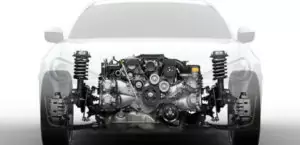The 1.4-liter Hyundai D4FC or 1.4 CRDi diesel engine was produced from 2010 to 2018 at a plant in Žilina, Slovakia and installed on models such as i20, i30, Rio, Ceed and Venga. There were two generations of such a unit: for Euro 5 environmental standards and updated for Euro 6.
At the very beginning of 2010, a 1.4-liter U2 diesel debuted on the Kia Venga model. The motor was offered in two versions of 75 and 90 hp, but with the same torque of 220 Nm. Structurally, this is a modern diesel unit for Euro 5 with a cast-iron block and an aluminum 16-valve DOHC cylinder head with hydraulic compensators, a timing chain drive, a conventional MHI TD025S2 turbine and a 1800 bar Bosch Common Rail fuel system.
In 2014, an updated version of this unit appeared for more stringent Euro 6, which was distinguished by a reduced compression ratio from 17 to 16 and a torque increased to 240 Nm.
The Hyundai U family also includes engines: D3FA, D4FA, D4FB, D4FD and D4FE.
The engine was installed on:
- Hyundai i20 1 (PB) in 2010 – 2012; i20 2 (GB) in 2014 – 2018;
- Hyundai ix20 1 (JC) in 2010 – 2018;
- Hyundai i30 2 (GD) in 2011 – 2015;
- Kia Ceed 2 (JD) in 2012 – 2013;
- Kia Venga 1 (YN) in 2010 – 2018;
- Kia Rio 3 (UB) in 2011 – 2017; Rio 4 (YB) in 2017 – 2018.
Specifications
| Production years | 2010-2018 |
| Displacement, cc | 1396 |
| Fuel system | Common Rail |
| Power output, hp | 75 – 90 |
| Torque output, Nm | 220 (EURO 5) 240 (EURO 6) |
| Cylinder block | cast iron R4 |
| Block head | aluminum 16v |
| Cylinder bore, mm | 75 |
| Piston stroke, mm | 79 |
| Compression ratio | 17.0 (EURO 5) 16.0 (EURO 6) |
| Hydraulic lifters | yes |
| Timing drive | chain |
| Turbocharging | yes |
| Recommended engine oil | 0W-30, 5W-30 |
| Engine oil capacity, liter | 5.7 |
| Fuel type | diesel |
| Euro standards | EURO 5 EURO 6 |
| Fuel consumption, L/100 km (for Hyundai i20 2015) — city — highway — combined |
4.5 3.3 3.7 |
| Engine lifespan, km | ~300 000 |
| Weight, kg | 152.3 |
Disadvantages of the Hyundai D4FC engine
- This diesel engine is equipped with a completely reliable Bosch Common Rail fuel system and on specialized forums they only complain about frequent failures of the fuel pressure regulator on the rail.
- A lot of trouble for the owner here is the rapid contamination of the intake manifold, it has to be cleaned every 50,000 km. About the same time, the EGR valve is clogged.
- A timing chain, consisting of a pair of roller chains, is distinguished by a very modest resource, sometimes they stretch out and rattle strongly already by 100,000 km, and when the chain jumps, the valves bend.
- Another weak point is not the most reliable low-pressure fuel pump, crankshaft position sensor and regular oil leaks from under the valve cover.






